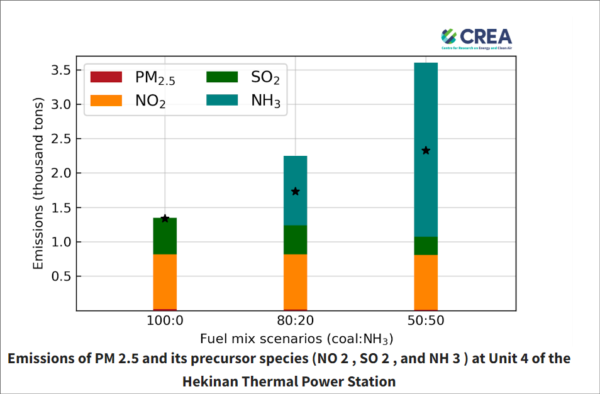On May 16th, Finland-based independent research think tank Centre for Research on Energy and Clean Air (CREA) published its report “Air quality implications of coal-ammonia co-firing”.
The report shows the impacts of coal-ammonia co-firing at Japan’s Hekinan Thermal Power Station Unit 4*. Based on its analysis, CREA concludes that the co-firing of ammonia will increase emissions of PM2.5 and other pollutants (SO2, NO2, NH3), from multiple processes in its life cycle, such as mining, production, transport, and combustion. The figure below illustrates just how much coal-ammonia co-firing increases emissions of PM2.5 and other pollutants.
* JERA will be starting a demonstration project at the Hekinan thermal power plant in 2023, utilizing 20% co-firing of ammonia in the 1 GW Unit 4. It plans to gradually increase the co-firing ratio until 2050 and eventually achieve 100% ammonia firing.
- The total emissions of PM2.5 and precursor gasses increase by 67% when NH3 displaces 20% of the energy demand, and by 167% when NH3 displaces 50% of the energy demand.
- These large increases in total emissions are due to the emissions of the PM2.5 precursor gas NH3, which are released during the shipping and combustion of this fuel. Therefore, considering the fuel life cycle as well, burning fuel ammonia for power generation will increase pollutant emissions.
- Ammonia released into the atmosphere leads to the formation of PM2.5 and the increased total emission of pollutants will likely lead to increased PM2.5 concentrations, and an even larger public health burden of this pollutant.

It should be noted that even if ammonia does not emit CO2 during combustion, the emissions of ammonia (NH3) increase significantly as the co-firing ratio increases, along with CO2 emissions over the life cycle, given that NH3 is a strong precursor to PM2.5.
Under the GX (Green Transformation) Promotion Bill, the Japanese government is strongly promoting ammonia co-firing in coal-fired power plants as part of its decarbonization strategy. The Ministry of Economy, Trade and Industry (METI) and JERA state that they have succeeded in reducing NOx (nitrogen oxide) emissions with 20% ammonia co-firing, but detailed information has not been made available, including the status of the co-firing experiments at Hekinan. Further research is needed to confirm the safety issues with increasing the ammonia-coal combustion ratio and with 100% ammonia on a large scale.
The report points out the risks to human health posed by the expansion of ammonia co-firing and recommends that more studies should be conducted on emissions and air quality if ammonia co-firing is expanded and co-firing rates are scaled up at any power plants in Japan or overseas.
CREA Press Release:
Japanʼs move to co-fire ammonia in coal power plants to have adverse impacts on air quality (PDF)
Report Download
Air quality implications of coal-ammonia co-firing (Link)
Related Articles
【News】Does the rest of the world really approve of Japan’s hydrogen/ammonia strategy?(Link)
Written/Published by: Centre for Research on Energy and Clean Air (CREA)
Published: May 16, 2023
